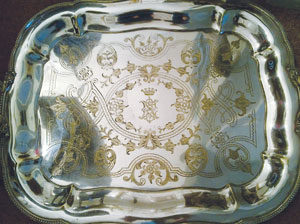
BR sends me a tray which has been in her family for 80-years. That makes it at least early 20th century. The fascinating thing about this silverplated tray is the ornate monogram with the five-pointed-star crown. This is a heraldic emblem called a “charge.” This monogram ‘ES’ is topped by a four-pointed crown or coronet, a constant device in heraldry, especially ecclesiastical heraldry.
I have two theories about BR’s monogram. Either it represents a family’s initials, or it means to evoke a revival period, in this case, the 17th century, when “The Winter Queen” reigned with her husband Frederick over Bohemia. In that case, the ES with a crown would stand for Elizabeth Stuart, the daughter of James I, the King of Scots, England & Ireland. Elizabeth became known as the Winter Queen because she and King Frederick only reigned over Bohemia for one winter.
We consider her an important figure because her grandson, George I began the Hanover line of succession in 1714. Queen Elizabeth of England is related to the present Queen Elizabeth ten generations later. The royal heads of Spain, Denmark, Norway, Belgium, Luxembourg, the Netherlands and Sweden today are also related to Elizabeth Stuart. The man I married in Scotland was also related to her. Adrian could trace his lineage to the Stuarts back to the 15th century, thus and I’m also Elizabeth Stewart!
She, for all her relatives today, lived an unhappy life in exile at the Hague, after losing her dear husband, and her brother who was executed in 1649, Charles I of England. She also lost many of her 13 children. This tray might reference Elizabeth the Winter Queen because in the late 19th or early 20th century the English loved to think of the good old Royal days of the past. Remember your visit to England where you saw all those Gothic parish churches? In fact we call those Gothic Revival, built in the late 19th century. Gothic was claimed as The English style, think of the 19th century building, the House of Parliament.
The crown with five points refers to the first origins of “crown,” the civic crown of Ancient Rome, made of round woven branches of oak, given for saving the life of a citizen. Of course the five points stand for the acorns. BR’s tray, however, has a more civilized heraldry! The intricate “chasings” are small pounded dots to make these designs, done by hand with a burin. A close-up of the handles reveals machine made rivets which put the date as the late 19th century. The value is $250.
A note about silverplate
This is not sterling silver. Scientists as far back as the early 19th century in England worked on an electromagnetic process by which to fuse copper and silver. Copper adheres using this process over silver, but no one wanted copper-plate! Experiments failed until an American named John Mead heard of those experiments in England and came over to attend lectures and to purchase a voltaic battery. Working the battery and with cyanide, Mead deposited silver on top of any metal. Mead and Rogers, of Rogers Brothers 1847 fame, began to market silverplated spoons for the first time in 1845. The invention of the Smee battery (zinc + silver+ sulfuric acid), by Alfred Smee of England, enabled Mead to invent silver plating. Silver plating became a famous and profitable American industry by the late 19th century. Anyone with middle-case means could look like he could afford silver.